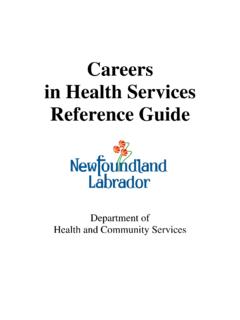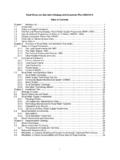Transcription of Provincial Home Support Program Review …
1 F Provincial Home Support Program Review Department of Health & community Services Final Report July 12, 2016. Deloitte LLP and affiliated entities. Proposal to serve the Government of Newfoundland and Labrador i Table of Contents Executive Summary 1. 1. Introduction 5. 2. Jurisdictional Scan and Literature Review 9. 3. Current State Review 13. 4. Future Demand for Services 48. 5. Future Program Vision 57. 6. Improvement Opportunities 59. 7. Concluding Remarks 71. 8. Appendices 72. Deloitte LLP and affiliated entities Government of Newfoundland and Labrador Provincial Home Support Program Review i Executive Summary Background The Provincial Home Support Program (PHSP) is part of a wider array of community Support services and is intended to enable eligible individuals who require assistance with activities of daily living to remain independent in their homes and communities. Ideally, the provision of home supports would prevent, delay or provide a substitute for institutional placement or acute care admission.
2 The Program is experiencing significant demand and funding growth which has led to the need to identify options to improve its effectiveness and gain Program efficiencies. Scope and Approach Deloitte Inc. (Deloitte) was engaged by the Department of Health and community Services (HCS) to complete a comprehensive Review of the PHSP to determine whether it is operating as efficiently and effectively as possible, to identify opportunities to improve the Program , and to inform changes required to help ensure its future sustainability. Moreover, the opportunities for improvement outlined in this report also take into consideration that the Program is integral to the sustainability of the broader health system and impacts adjacent programs and services. The Review consisted of four phases of work over a 16-week period and was guided by a Steering Committee comprised of Program leadership from HCS and the four Regional Health Authorities (RHAs).
3 The Review was completed through an iterative process, involving extensive consultations with internal and external stakeholders, a jurisdictional scan and literature Review , data collection and analysis, and regular meetings and several workshops with the Steering Committee. Over 315 individual stakeholders representing HCS, the RHAs, clients, home Support workers, agencies, industry associations, bookkeepers, and client advocacy groups were engaged throughout the Review . Jurisdictional Scan and Literature Review To inform the Review from a leading practices standpoint, a jurisdictional scan and literature Review was completed. Primary and secondary research methods revealed: Performance metrics demonstrated by British Columbia, Alberta, Saskatchewan and Nova Scotia suggest their programs are the most mature of the Canadian provinces;. There are key differences and similarities in how home Support services are administered and delivered in Newfoundland and Labrador compared to these jurisdictions.
4 Most notably, the comparator jurisdictions have: Simpler financial eligibility criteria and streamlined assessment processes;. Defined home Support worker (HSW) qualification and educational requirements; and, Established performance management systems;. The role of home Support services in enhancing health system performance is evolving as these provinces are: Starting to rely more on outcomes and measurement with a shift toward paying for outcomes, not simply hours of service; and, Progressively utilizing home supports and other community care programs as a means to address capacity and cost effectiveness challenges in other care settings;. Deloitte LLP and affiliated entities Government of Newfoundland and Labrador Provincial Home Support Program Review 1. Home Support workers scope of practice is expanding with a focus on improving coordination with professional clinical teams;. The efficiency and continuity of care delivery are being enhanced through technology; and, Transactional activities are being centralized to leverage economies of scale and reduce costs.
5 In addition, the Review identified that the leading models of community -based care Support are able to improve client outcomes through: The creation of integrated teams and multi-sector partnerships around clients to help them receive care closer to home;. Utilizing technology in new and innovative ways to help caregivers and health providers communicate better and monitor clients remotely; and, Shift expertise and expand scopes of practice. Current State Review An in-depth Review of the current state of the Program was completed across its four key areas: (i) Intake and Referral, (ii) Assessment, Planning, and Co-ordination, (iii) Home Supports Delivery, and (iv). Monitoring and Policy Development. The current state Review considered business processes, staffing models, service delivery models, funding models, Program eligibility, and policy standards to identify opportunities to improve the efficiency and effectiveness in each of these areas.
6 The key findings from this aspect of the Review are as follows: There is significant variation between the RHAs in delivering most aspects of the Program1;. These variations are also present in Program utilization, referrals, approvals, exemptions and workloads which suggests inequitable access to the Program across the Province;. The predominant clinical assessment tool used was found to have several limitations and the approval of supports may be above the minimal level required to maintain client independence;. Although the financial assessment is considered to be important to determine eligibility for subsidized home Support services and an appropriate and equitable co-pay, some staff and clients of the Program consider the financial assessment process to be resource intensive, burdensome and invasive, especially the Needs Test;. The integration of home Support services with other community Support programs and services is limited.
7 Monitoring and oversight of home Support services delivery is lacking across both agency-based and self-managed care options;. Home Support workers lack a defined set of qualifications and a viable career path relative to other occupations. This creates challenges in staff attraction and retention and adversely impacts the consistent provision of quality supports;. The Provincial Operational Standards including Program goals are dated and are in need of revision;. and, The Program 's data collection and Program measurement are lacking in several areas as there is limited ongoing attention to Program performance and client outcomes. 1. It is important to note that some of the variation may be a result of differing data availability and reporting abilities across regions. In many areas, standardized data was not available so the best available data was used to analyze Program areas. Deloitte LLP and affiliated entities Government of Newfoundland and Labrador Provincial Home Support Program Review 2.
8 Through a telephone survey conducted with 131 clients, the Program was rated highly in meeting the needs of its clients, which suggests a high degree of effectiveness of the Program . While client satisfaction was largely consistent across RHAs, adults with disabilities reported lower satisfaction relative to other client groups across all measures. While the results of the client survey were encouraging, and there is a general consensus among stakeholders that the Program is meeting its goals, the Review identified evidence suggesting the Program is not fully meeting its goals as set forth within the current policy framework. Despite clients having a significant degree of choice in how their independence is supported by the Program , inconsistency with respect to the appropriateness of approved Support hours and the application of policies across regions and client groups was observed. Future Demand for Services and Vision As increasing demand for home Support services was one of the key factors that precipitated the Review of the Program , a predictive model of demand was developed to inform Program planning and the assessment of future fiscal sustainability.
9 Based on factors such as shifting population demographics, public health trends, and historical cost escalation, it is estimated that overall Program caseloads will increase by approximately 14% over the next five years. Moreover, without policy intervention, this change in demand will result in a $53 million increase in annual subsidy expenditures and additional RHA. resources to administer the Program . The magnitude of the forecasted increase in Program caseloads and expenditures and the prevailing fiscal climate create a powerful case for change. Consequently, the Steering Committee developed a new vision and a set of guiding principles for the Program on which to build the opportunities for improvement and align the participation of stakeholders. All citizens of the Province have access to the home Support services they need to help them remain independent in their homes and communities, avoid unnecessary hospitalization and long-term care placement, and maintain their well-being.
10 Furthermore, the attainment of this vision will be informed by a set of monitoring and evaluation indicators, the most critical of which include: Reducing the time for clients to be assessed and receive supports;. Increasing the percentage of eligible populations accessing the Program and avoiding institutional placement;. Increasing the number of clients with individualized community inclusion plans; and, Increasing family and caregiver participation in the development of the client's service plan. Improvement Opportunities In total, 25 opportunities to improve the Program were identified along with an implementation strategy and roadmap. The opportunities that represent the highest return on implementation effort include: Enhancing clinical assessment tools and implementing hours-based service limits to more accurately define and communicate client care needs;. Improving the hand-off of service plans to care providers to improve the continuity of care and eliminate redundant reassessments.













